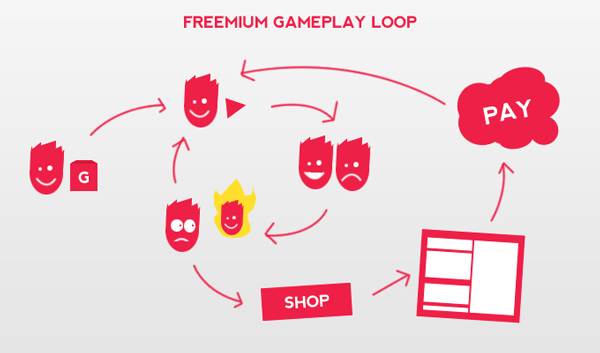In this post, I’ll define the concept of freemium – an increasingly popular business model for online games. You’ll learn how an freemium game loop works, and perhaps you’ll be inspired to implement it in a future game…
The Concept
In a nutshell: a freemium game is one that you can play, for free, for an unlimited time, but that also offers advantages to players that spend some cash on premium items.
These items could be magic spells, higher character stats, more health points, secret characters, or special weapons. They could even be purely aesthetic items, like hats, that just customise your in-game avatar and offer no benefit beyond that.
Unlike a shareware game, a freemium game doesn’t require you to buy anything, ever; you can play it normally without spending a penny, but to really get everything out of the game you’ll have to pay.
Freemium game designers need to define a clear line between the free and paid. This line needs to be thin; the free items must be great enough to let the player have fun and slowly turn into an addict, while the paid items must be desirable without offering too great an advantage to those players who spend their cash.
How It Works
Freemium games typically don’t have an “end”; they are games that you just play and play and play. Instead of levels and boss fights they’ll usually feature objectives and… more objectives.
They are usually multiplayer, too – it’s hard to find a single player freemium game, since this would only let you use your paid advantages against the computer, and not against (or alongside) other people around the world.
The “ideal loop” of a freemium game looks like this:
- The player downloads and installs the game.
- He begins to play with free items.
- He’ll be able to kill some enemies or complete some objectives – but it’s a bit hard, he loses more than wins. He’ll repeat this step until either he becomes an addict or he uninstalls the game.
- He’ll see another players using amazing items and playing better because of them; here he’ll notice the Shop area of the game.
- He’ll spend some time scrolling through all the items he could get and imagining playing with them. (This is why it’s important for the items to be desirable.)
- He’ll buy the items he wants and head back to the game.
- He’ll repeat the above steps until the game shuts down, he gets bored, or something forces him to change his habits.
Looking at this list, we can see a few important points such a game needs to fulfil:
- You need to create free items and a free gameplay that the player really likes.
- You need to create amazing paid items that feel like they’re worth actual money, without them offering such a big advantage that they’d unbalance the gameplay.
- You need to set great prices and have a lot of premium items to have a better chance of enticing your player to buy something.
I put together this little diagram to illustrate this:

In the diagram you can see that the user must win and lose; another important factor is that he must see a special item in the hands of another user who is playing very well. Then, the user will either head back to the game without any premium items, or he’ll buy something first.
Some Games That Are Freemium
Let’s look at a few successful examples:
If you’re familiar with these games, you’ll notice that they’re quite varied. FarmVille has no battles, Team Fortress 2 is round-based, and so on.
Some companies profit purely off this business model. If you can create a game with a good balance between free and premium items, and where the free users can see the premium users playing well because of their paid items, you may well have a game that will bring a great income for you or your company!